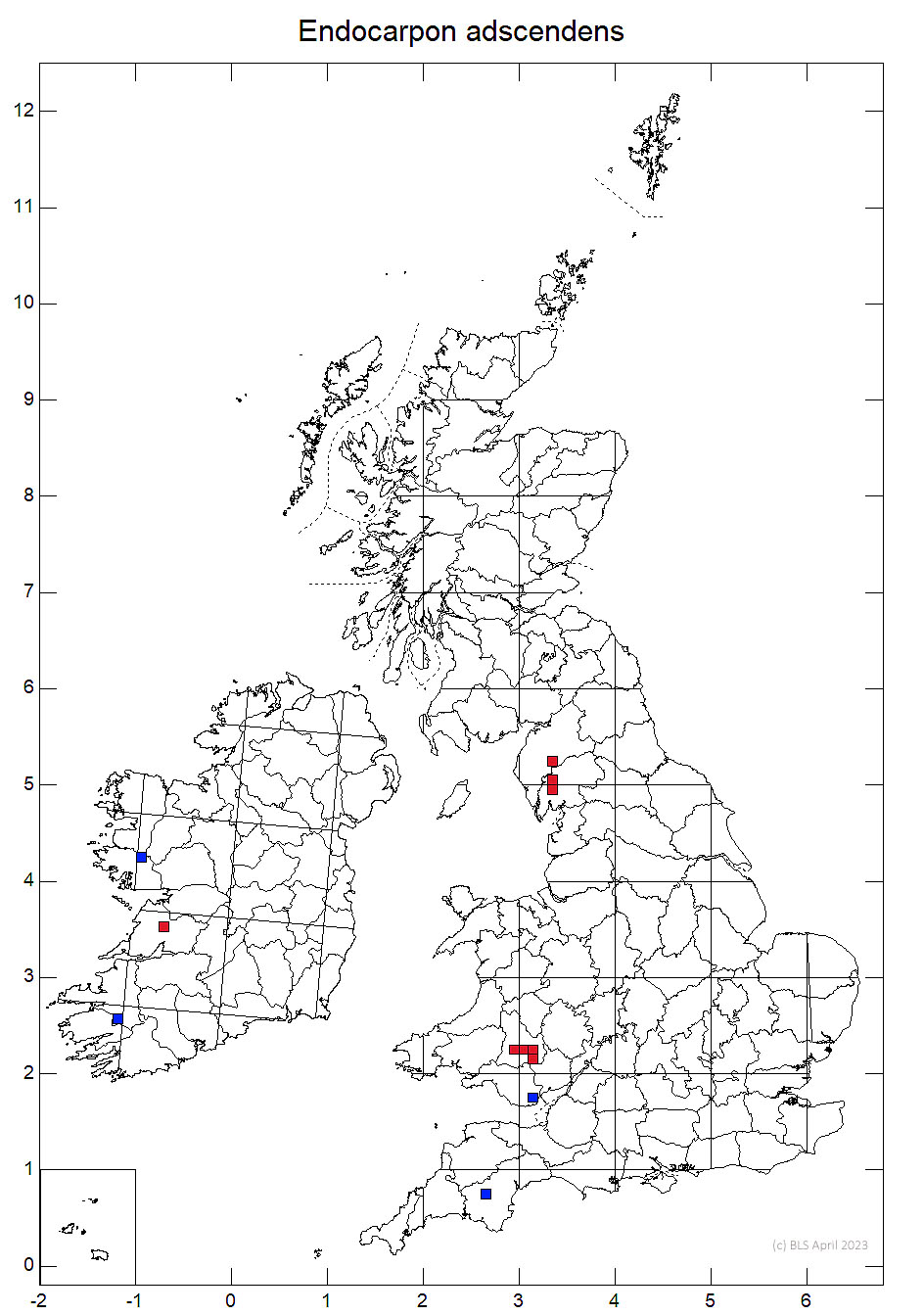The thallus consists of small (0.3-1.5mm) elongate to rounded beige or greenish brown squamules that often overlap. The black tips of one or two buried perithecia can often be seen protruding from the centre of the lobes. Tiny hyphae attach it to the substrate (unlike the well developed blackish rhizines of the similar E. pusillum). Microscopic examination is required to confirm the genus and separate it from superficially similar genera such as Catapyrenium, Dermatocarpon and Placidiopsis. In Endocarpon spp. algae are present amongst the asci in the perithecia.
Three species of this genus are reported from Britain. All are rare and somewhat difficult to differentiate. Expert help should be sought. Some doubt still attaches to the identity of the Welsh material as a different species is reported from rivers in Europe (A. Orange pers comm). Both E. adscendens and E. pusillum are reported from Wales (A. Orange pers comm and report to CCW entitled "A Baseline Survey of Rare Lichen Species in South Area" by AO (1997)). E. pusillum is known from a railway cutting on limestone near Bridgend and elsewhere from Devon, Dorset and Yorkshire. E. pallidulum, a lichen of greensand walls and damp limestone with smaller spores than E. adscendens is only known from Dorset.
In Wales it is reported from boulders and the stems of the moss Thamnobryum alopecurum in the flood zone of the R. Usk in Breconshire in a scatter of sites from Sennybridge to just below Llangynidr and from reddish limestones blocks constructed to form a naturalistic outfall to a pond at St.Fagans Castle, Cardiff, Glamorgan. The following 15cm x 15cm quadrats were made at this latter site by Alan Orange in 1997 with cover estimates using the Domin scale.
| QUADRAT NUMBER | 1 | 2 | 3 | 4 |
| Endocarpon adscendens | 4 | 5 | 5 | 6 |
| Cinclidotus mucronatus | 4 | 5 | 4 | 7 |
| Verrucaria baldensis | 4 | 4 | 5 | |
| Oxystegus sinuosus | 4 | 4 | 1 | |
| Cardamine hirsuta | 5 | 2 | 2 | |
| Collema tenax | 3 | 2 | 1 | |
| Sagina procumbens | 1 | 1 | 2 | |
| Collema crispum | 1 | 2 | 1 | |
| Agrostis stolonifera | 4 | |||
| Caloplaca ? dalmatica | 2 | |||
| Cerastium fontanum | 2 | |||
| Verrucaria sp. | 1 | |||
| Fissidens sp. | 1 | |||
| Bellis perennis | 1 | |||
| Rock | 7 | 5 | 4 | 6 |
Full details of the St Fagans site, Glamorgan are provided in an attached document (Orange 1997). In the R. Usk the populations are small, scattered and occur on large ORS boulders only occasionally completely flooded by the river. Around Llangynidr they have declined in vigour and extent in the last twenty years.Elsewhere in Britain it occurs beside the R. Dart in Devon, the Teme in Downton Gorge, Herefordshire and beside Lake Windermere in the NW of England. There may also be a record from the R. Warfe in the Pennines. In Ireland it occurs in Kerry and Connemara.
It occurs rarely but widely in the rest of the world.(RGW)
Orange (1997) provides detail about the St Fagans and Bridgend sites. In the R. Usk the populations are small, scattered and around Llangynidr have declined in vigour and extent in the last twenty years.
Increasing silt levels possibly threaten its R. Usk sites. The St Fagans population is tiny and extends over c 4 sq m. Yet it possibly has occured here since 1947.
1. Through DNA sequencing establish a firm taxonomic base for the Welsh material.
2. Map the extent and size of population in the R. Usk as a base for future surveillance.
3. Collect data on associated species and threats to the R. Usk population.
Orange, A. (1997) "A Baseline Survey of Rare Lichen Species in South Area". Report to the Countryside Council for Wales (Contract number FC 73-07-06).
- Log in to post comments

